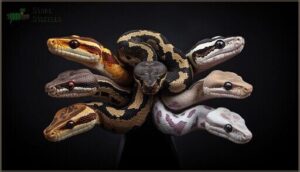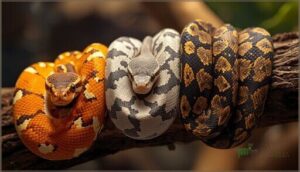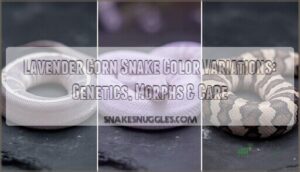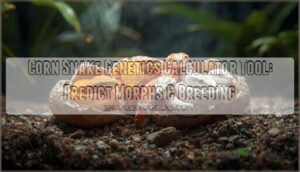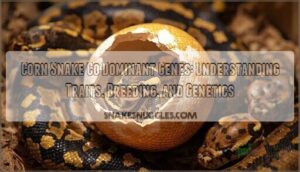This site is supported by our readers. We may earn a commission, at no cost to you, if you purchase through links.

Your corn snake’s vibrant tangerine blotches or ghostly alabaster scales didn’t appear by chance—they’re the result of specific alleles passed down from parents to offspring. These recessive traits hide within a snake’s genetic code, often invisible for generations until two carriers produce offspring that express the hidden mutation.
Understanding corn snake genetics transforms breeding from guesswork into predictable science, allowing you to anticipate which hatchlings will display amelanism, anerythrism, or other coveted morphs. Recessive inheritance follows Mendelian patterns, meaning you can calculate the odds of producing specific colorations before pairing your breeding stock.
Mastering these genetic principles helps you make informed decisions, maintain healthy lineages, and reveal the full spectrum of corn snake color possibilities.
Table Of Contents
Key Takeaways
- Recessive traits in corn snakes follow Mendelian inheritance patterns, meaning you can predict offspring morphs using Punnett squares before breeding by calculating the probability that hidden alleles will express in hatchlings.
- Major recessive mutations like amelanism (blocks melanin entirely, creating red/orange snakes with pink eyes), anerythrism (eliminates red/orange pigments for grayscale patterns), and hypomelanism (reduces but doesn’t eliminate melanin) create the foundation for popular morphs and combination varieties.
- Breeding two heterozygous carriers of a recessive trait produces approximately 25% visual offspring expressing that trait, while pairing a homozygous recessive with a heterozygous carrier yields roughly 50% visual morphs.
- Successful breeding programs require meticulous record-keeping to track hidden alleles across generations, regular outcrossing to maintain genetic diversity and prevent inbreeding depression, and ethical prioritization of animal welfare over aesthetic goals.
Basics of Corn Snake Genetics
Understanding how corn snakes inherit their striking colors and patterns starts with a few fundamental genetic principles. You don’t need a biology degree to grasp the basics—just a clear picture of how traits pass from parents to offspring.
Let’s break down the core concepts that govern corn snake genetics.
Genes, Alleles, and Inheritance
Your corn snake carries 36 chromosomes packed with genes that control color and pattern through Mendelian inheritance. Each gene has different forms called alleles—one from each parent. These allele interactions determine gene expression, creating the genotype (genetic code) and phenotype (visible traits).
Understanding this heritability lets you predict genetic mutations using Punnett squares before eggs even hatch. Breeders use this tool to determine probability per egg of specific traits.
Dominant Vs. Recessive Traits
Dominant alleles mask recessive ones when you breed your snakes. A single dominant allele expresses the trait, while recessive traits need two copies to show. That’s why normal-colored snakes can carry hidden recessive alleles for amelanism or anerythrism without phenotype masking. Het identification requires breeding ratios or genetic testing. Trait expression follows Mendelian inheritance patterns you can predict using Punnett squares to track genetic carriers through multiple generations. Understanding snake’s genetic makeup is essential for predicting offspring traits.
- Dominant traits always express when at least one allele is present
- Recessive traits require homozygous pairing for visible expression
- Heterozygous snakes carry recessive genes without showing them
- Breeding ratios reveal hidden genetic carriers in your collection
- Phenotype masking conceals recessive alleles in normal-appearing snakes
Genotype and Phenotype in Corn Snakes
Your snake’s genotype is its genetic blueprint—the alleles it carries at pigment loci—while its phenotype is what you actually see: color, pattern, scale texture.
Genotype prediction using Punnett squares and Mendelian inheritance drives corn snake breeding decisions. Genetic testing confirms carriers of recessive traits, improving breeding ethics and phenotype expressivity outcomes.
Environmental influence on coloration remains minimal compared to genetic determinants in these reptiles.
Key Recessive Traits in Corn Snakes
Recessive traits in corn snakes are the building blocks that make selective breeding predictable and exciting. Understanding these mutations gives you the power to forecast what your breeding pairs will produce before the eggs even hatch.
Let’s look at four major recessive traits that have shaped the corn snake hobby.
Amelanism (Albino Morph)
When you’re diving into snake genetics, amelanism stands out as the cornerstone morph. This recessive genetic mutation disrupts the OCA2 gene, blocking melanin production entirely. Albino identification is straightforward—you’ll see vibrant reds and oranges against white backgrounds, plus those telltale pink eyes.
Historical origins trace back to Dr. Bernard Bechtel’s 1961 discovery.
Breeding albinos follows predictable patterns:
- Two amelanistic corn snakes produce 100% albino offspring
- Heterozygous carriers look normal but pass hidden alleles
- Phenotype variations depend on which pigments remain intact
Anerythrism (Anery Morph)
Grayscale coloration defines anerythristic corn snakes—a recessive genetic mutation that strips away red and orange pigments entirely. You’ll recognize anery genetics through charcoal, gray, and white patterns, sometimes with subtle brown undertones.
Breeding outcomes follow standard Mendelian ratios: two carriers produce roughly 25% anery offspring. Phenotype variations emerge when you pair anerythrism with other traits, creating popular color morphs like Ghost and Snow that drive morph popularity.
Hypomelanism
Reduced melanin production—not total absence—distinguishes hypomelanistic corn snakes from their amelanistic cousins. You’ll spot brighter oranges and reds with dark eyes intact, caused by downregulated tyrosinase enzyme activity in melanophores.
This recessive trait follows standard Mendelian inheritance: two carriers yield approximately 25% visual hypos.
Breeders favor hypomelanism for creating vibrant color morphs while preserving pattern definition, making it exceptionally popular in captive breeding programs.
Scaleless Mutation
A 2-nucleotide deletion in the EDARADD gene disrupts scale development across dorsal and lateral surfaces while preserving ventral scales for movement. This recessive mutation emerged in 2002 from a corn snake and great plains rat snake cross, producing strikingly vivid colors but creating breeding challenges.
You’ll face reduced fertility and hatching difficulties requiring careful husbandry needs when working with this morph.
How Recessive Traits Are Inherited
Understanding how recessive traits pass from parent to offspring is the foundation of successful corn snake breeding. You don’t need a genetics degree to grasp these concepts—Mendelian inheritance follows predictable patterns that you can map out before your snakes even mate.
Let’s break down the three core principles that determine which traits appear in your hatchlings.
Mendelian Inheritance Principles
When you breed corn snakes, you’re working with Mendelian Genetics—the foundation of trait prediction. Two core principles guide inheritance: Allele Segregation means each parent passes one allele per gene, while Independent Assortment shows traits on different chromosomes combine freely.
Understanding how alleles determine both Genotype (genetic makeup) and Phenotype (visible appearance) lets you forecast offspring with precision, setting the stage for accurate Phenotype Prediction through Genotype Ratios and Punnett Square analysis.
Punnett Squares in Corn Snake Breeding
Punnett Squares transform Snake Genetics from guesswork into calculated predictions. You arrange each parent’s alleles along the grid’s edges, then fill cells to reveal every possible genetic combination your offspring might inherit.
- Each cell represents one potential genotype from combining parental alleles
- Four-cell grids map single traits; sixteen-cell grids handle Double recessives
- Recessive probabilities become clear: 25% visual morphs from two heterozygous carriers
- Genetic calculators automate these predictions, reducing errors in Breeding decisions
- Square limitations exist—they show probabilities, not guarantees in small clutches
Double Recessive Pairings (e.g., Snow Morphs)
Snow morphs showcase what happens when you combine amelanistic and anerythristic genes—two recessive traits creating one striking double recessive pairing. Breeding outcomes follow predictable ratios: two heterozygous carriers yield just 6.25% snow corn offspring.
Genetic testing now helps confirm these double recessives before breeding, addressing morph prevalence tracking and diversity concerns. Snow morph ID requires recognizing both absent pigments in these genetic mutations.
Identifying Recessive Morphs and Their Genetics
Spotting a recessive morph isn’t always straightforward, especially when you’re working with het animals that carry hidden genes. You’ll need to rely on visual cues when they’re available and solid documentation when they’re not.
Let’s break down how you can identify these morphs through what you see and what you track.
Visual Markers of Recessive Morphs
Morph identification starts with visible traits that make each snake unique. You’ll need to observe pattern variations, eye coloration, and scale appearance to determine what you’re working with. These markers directly predict breeding outcomes when you understand their genetic basis.
- Amelanistic snakes lack black pigment entirely, showing bright orange and red saddles over white bodies with pink or red eyes
- Anerythristic morphs eliminate warm tones completely, displaying stark gray and black patterns with dark brown eyes
- Hypomelanistic individuals show faded black markings with softer contrast compared to wild-type corn snakes
- Lavender morph snakes exhibit diluted gray-purple coloration resulting from the LYST gene mutation
- Palmetto morph presents extreme white patterning with scattered colored scales across the body
Breeder Record-Keeping and Lineage Tracking
Spotting a visual marker is only half the story—what seals the deal in Corn Snake Breeding is careful record-keeping. Using digital tools or classic index cards, you log parentage, breeding dates, shedding, and health.
Data accuracy isn’t just paperwork; it guides ethical breeding, verifies mutations, ensures genetic diversity, and keeps your Animal Husbandry and Breeding practices rock solid for future projects.
Breeding Strategies for Recessive Traits
Breeding for recessive traits isn’t about rolling the dice and hoping for the best. You need a clear strategy that starts with choosing the right parent snakes, maintains healthy genetic diversity across your collection, and respects the ethical boundaries that keep this hobby sustainable.
Let’s break down each component so you can breed responsibly and produce the morphs you’re aiming for.
Selecting Parent Snakes
Your breeding success starts with genotype confirmation and understanding phenotype variations in your parent snakes. You’ll need to identify whether each snake is homozygous recessive, heterozygous, or normal.
Record-keeping tracks these genetic pairings across generations, helping you avoid mismatched allele locations in corn snake breeding. Pairing a homozygous recessive with a heterozygous carrier produces roughly 50% recessive offspring, while two heterozygous parents yield about 25%.
Maintaining Genetic Diversity
Genetic diversity protects your breeding program from inbreeding risks and genetic bottlenecks. Outcrossing strategies introduce unrelated bloodlines, boosting genetic variation and reducing homozygosity in recessive traits. You’ll want to avoid pairing closely related snakes repeatedly, as this accelerates allelic loss.
Genetic monitoring through detailed record-keeping tracks recessive impact across generations. Snake breeding prioritizes genetic diversity and conservation, ensuring your corn snakes maintain adaptive potential and long-term population health.
Ethical Considerations in Recessive Trait Breeding
Responsibility sits at the heart of every breeding decision you make. Your welfare standards must balance aesthetic goals with genetic health, following established ethical considerations that prioritize animal wellbeing over profit.
Ethical breeding demands that you balance aesthetic ambitions with genetic health, always placing animal welfare above profit
- Inbreeding Risks: Track coefficients of inbreeding (COI) to prevent deleterious recessive alleles from accumulating across generations in your reptile breeding program.
- Genetic Diversity: Outcross regularly after linebreeding to maintain population health and reduce inherited disorders.
- Breeder Roles: Document lineage and health records thoroughly, ensuring transparency in snake breeding techniques and animal husbandry practices.
- Public Perception: Address welfare concerns proactively as consumer awareness drives demand for ethical reptile breeding standards.
Frequently Asked Questions (FAQs)
Can recessive traits skip multiple generations unexpectedly?
Like buried treasure, recessive traits can reappear after generations when hidden alleles resurface through cryptic transmission.
Carrier prevalence makes unexpected reappearance common—you won’t see the genotype until two carriers meet.
How do temperature and incubation affect recessive morphs?
Temperature during incubation directly shapes pigment deposition and embryonic growth in recessive morphs.
Thermal regulation between 78°F and 84°F fosters metabolic shifts, ensuring proper color expression and survival fitness in corn snake breeding programs.
Are recessive mutations linked to health problems?
You might worry that recessive morph health takes a hit, but mutation health effects in corn snakes are minimal.
Recessive morphs like amelanistic and anerythristic display normal phenotypic expression without physiological disorders.
What happens when breeding three recessive traits together?
Breeding for triple recessive traits creates significant challenges. You’ll see only about 56% of offspring express all three phenotypes from heterozygous parents.
Punnett squares help predict these complex inheritance patterns, but genetic confirmation remains essential.
Do recessive morphs have different feeding or temperament?
No peer-reviewed studies show recessive morphs affect feeding response or temperament in corn snakes. Amelanistic, anerythristic, and scaleless individuals display normal eating patterns and gentle dispositions identical to wild-type snakes.
Conclusion
One unexpected pairing can reveal morphs you didn’t know your collection carried—hidden alleles waiting beneath normal scales. That’s the power of understanding corn snake genetics recessive traits: what looks ordinary today might produce snow morphs, scaleless offspring, or striking amelanistic hatchlings tomorrow.
Your breeding decisions ripple through generations, shaping color patterns years ahead. With Punnett squares, careful records, and strategic pairings, you’re not just breeding snakes—you’re decoding their genetic blueprint one clutch at a time.



